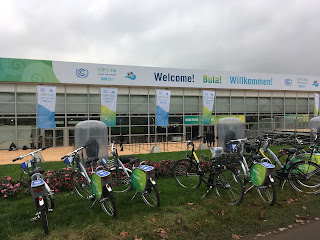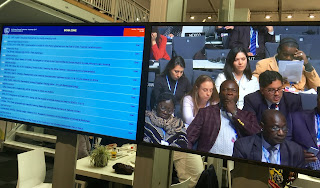I’m at the annual UN Climate Change conference, which opened today in Bonn, as a guest of the German Development
Institute. For those who haven’t attended one of these events before, I thought
I’d provide a brief overview of what goes on in general, and what it’s like at
this one in particular. It’s an unusual phenomenon; part UN negotiations, part
conference, part trade fair, with a little bit of carnival thrown in as well
(complete with ferris wheel).
Bikes outside the entrance to the Bonn Zone.
Each year, in November or December, a COP session
is held in a different country to take stock of progress made to date and to
identify next steps in implementing the UNFCCC. The specific agenda items vary
from one year to the next. For example, at the third COP in Kyoto, developed
nations agreed to set specific targets for reducing their GHG emissions by
2012, which became known as the Kyoto Protocol. At COP 16 in Cancun, signatories
agreed to set up a Green Climate Fund to help finance clean development
projects in developing countries, and established the Cancun Adaptation
Framework to reduce vulnerability and build resilience in developing countries
(these terms adaptation, vulnerability, resilience are important in UNFCCC
parlance). At COP21, the Paris Agreement was negotiated, in which countries
promised to take the steps necessary to prevent global average temperatures
from warming no more than 2oC this century, through “nationally
determined contributions” (i.e. each country promises to do its best to help
control GHG emissions).
Cynics point out that what countries agree
to do at COPs is often not matched by action afterwards. For example, few
countries actually met their GHG emissions targets under the Kyoto Protocol;
emissions actually went up in many countries, including Canada. The Green
Climate Fund relies on voluntary contributions from wealthy countries; although
the vision was to have US$100 billion/year available for projects in poorer
countries, for so far only US$10 billion has been donated in total. As for the
Paris Agreement, few countries have begun taking action on their nationally determined
contributions, and scientists are warning there is no way warming can be kept to 2oC if things don’t change quickly. I tend to be less cynical: at
least the world’s nations are meeting regularly to discuss how to make progress
on climate change. Think of all the global challenges that don’t get near as
much consistent, ongoing attention.
Although this year’s COP is being held in
Bonn, the official host is the government of Fiji. Bringing thousands of international
delegates to a small Pacific island was seen as being too great a logistical
and financial challenging, so it was decided to hold in Bonn, where the UNFCCC
secretariat is permanently based and the necessary conference infrastructure
exists, so that the Fijian government could focus on carrying out the meeting’s
agenda. So what’s on the agenda? It focuses on specific steps needed to
implement the broad aims of the Paris Agreement, on topics such as emissions
reductions, adaptation assistance, and compensation of vulnerable nations for
losses and damage experienced due to anthropogenic climate change.
Those attending the COP include official
delegations from governments that will be negotiating with one another and
non-official delegations that represent a wide variety of organizations,
including advocacy groups, non-government organizations think tanks, research
institutes and universities, among others. Two separate temporary meeting
venues have been set up in Bonn. The official delegations are meeting at the
Bula Zone, located in the UN district, a part of town that features many former
government buildings that were repurposed when the capital of a reunified
Germany was moved from Bonn to Berlin. In practice, governments are continually
discussing and negotiating with one another year round, but the COP provides
them the annual opportunity to formalize these discussions and make concrete
agreements. It’s a slow, ongoing progress, with the delegates often working
late on the final day of the COP to agree upon their official announcement of
what has been accomplished. No one expects anything particularly groundbreaking
to be agreed upon at this COP; the more likely outcome is a range of technical statements
and general declarations of continued intention to implement the Paris
Agreement.
The non-official representatives are meeting
at a separate venue called the Bonn Zone, a temporary pavilion in a park a few
kilometers distant from the Bula Zone. The Bonn Zone hosts what are referred to
as Official Side Events – presentations, exhibitions, and similar things
intended to inform attendees what the displaying organization is thinking or doing
about climate change, some with the underlying goal of trying to influence what
is happening in the Bula Zone (whether this actually happens is debatable).
Also, the Bonn Zone offers attendees a venue where they can network with other
people involved in climate change action and advocacy. It’s not open to the
public; you can’t just walk in off the street and find out what’s going on in
the world of climate change negotiations. Rather, organizations need to
register well in advance and request admission passes for their members, and
these passes are rationed. I’m entering the Bonn Zone this week on a pass
obtained for me by the Interdisciplinary Centre on Climate Change based at the
University of Waterloo.
Views from inside the COP Bonn Zone.
Finally there are the non-official side
events. These include formal events that are not hosted inside the official
Bonn Zone, such as the 40+ workshops being hosted by the German Development Institute in which I’ll be participating. It’s deliberately being held in a
place where the general public can attend, as well as employees of the many government and international agencies based in Bonn who don’t have access to the official
side events. There was also an organized protest in Bonn on Sunday, where
thousands of people marched to demand that Germany reduce its dependence on
coal.
What types of people attend COP side
events? I went to a few today and chatted to attendees that included civil
servants, a development agency employee, a soil scientist, graduate students,
and even one undergraduate student from Vancouver, who is part of a youth
delegation sponsored by the province of British Columbia. She’s majoring in
international relations, and told me how cool it was to attend a real UN
meeting (she had done lots of model UN activities in past courses). As you can
see from my somewhat random sample, attendees come from a wide range of
backgrounds, and they come from around the world (though a disproportionate
number of them are from North America and Europe).
Hopefully that gives you a decent picture
of what’s going on here at COP23. If you’re interested or engaged in climate
policy, it is definitely worth the effort to attend one of these events at
least once, so you can see the context in which international climate discussions
take place. I’ll be posting some photos and comments on my Facebook page and
Twitter feed for anyone who’s interested in seeing more. Oh, and here's a photo of the ferris wheel outside the Bonn Zone.
.





No comments:
Post a Comment